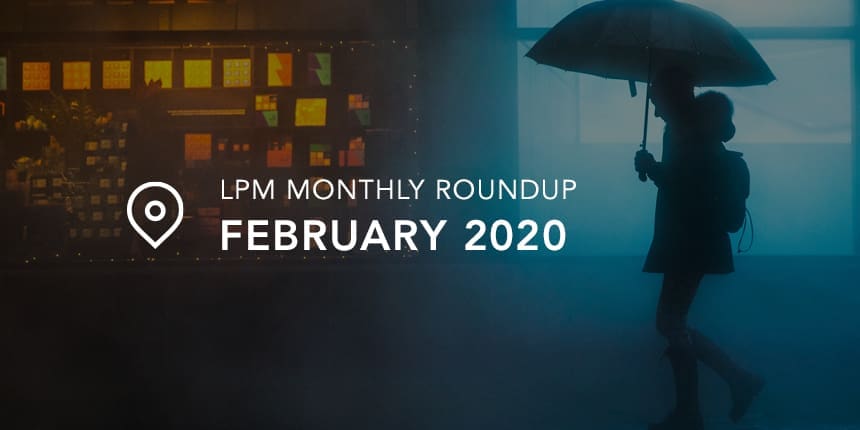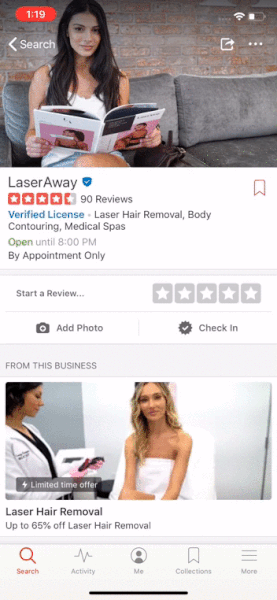
 February-2020-lpm-roundup
February-2020-lpm-roundup 
February was a tumultuous month for Google. Multiple updates, minor tweaks, and even a couple of glaring errors saw much change in the local search ecosystem this month—especially in Europe. Here’s everything you need to know.
Google links to third-party rivals on European SERPs
In a move that can only be detrimental to Google, branded buttons for its rival directories are being displayed above the map in some Google search results in Europe. Why? Because Google needs to comply with several European antitrust lawsuits.
In 2017, it was subject to a $2.7 billion antitrust fine for favoring its own content in search results. Then, in 2018, the EU antitrust unit began exploring broader local search complaints against Google. In an attempt to avoid further penalization from the EU, Google has begun to show its competitor’s directories prominently in search results.
It’s clear that this change is going to increase the exposure of directories outside of Google. The links are very prominent and will lead to more businesses listing in places such as Yelp and Cylex. But those additional listings will need to be maintained by businesses so that users aren’t suddenly subjected to poor user experiences.

But how are these directories are selected? There is no “sponsored” or “ad” designation, so it can only be assumed they are chosen organically (paid placement on Google for competing directories would also not in any way assist in their attempts to avoid further antitrust lawsuits!). Google has not given away its exact criteria, but in some cases the directories appear on the first page of the organic results, below the map; in other cases, they do not.
This change may be permanent if it appeases the EU commission, but you can be sure that Google will quickly backpedal if it doesn’t steer them clear of yet more antitrust accusations. This will partially depend on if these SERP results drive meaningful traffic to these other directories. If it is seen as a token effort by the EU commission and doesn’t curb Google’s monopolistic practices, then Google will have to find different means of compliance or otherwise suffer another hefty fine.
Yelp launches Showcase Ads and store visits attribution
Yelp has launched two new features to its platform: Showcase Ads and Yelp Store Visits (YSV) attribution. Both are intended for national and multi-location brands.
Showcase Ads are marketed as “video-centric”, meaning video content is mandatory to take advantage of this ad space. It is a slideshow of images (or short videos) which can be used to promote limited-time offers or specials. Anyone who has scrolled through their Twitter feed or other social platforms can attest to how a moving images catch the eye much more effectively than a still picture or plain text. Yelp has claimed that Denny’s and other large brands have tested this new feature prior to the announcement with successful results. They did not, however, offer any specifics.

Yelp Store Visits is a new first-party attribution tool that provides businesses with an accurate picture of how their ads are performing on Yelp. The YSV will report a cost-per-visit metric, which in turn will hopefully lead to more accurate ROI estimates for ad spend.
The new ad format and attribution tool shows Yelp’s intent to compete more with Google (while adopting some of their monetization practices). The Showcase Ads are strikingly similar to Google Posts and the UI of a Google My Business (GMB) profile. Attribution tools are, of course, very important when focusing on this ad-based strategy: without proper attribution, paying for ads can be like throwing money down the drain. Yelp also has the advantage of having “high intent” users, which could make advertising efforts more effective. If the new features do well with national brands, we may see them rolled out for smaller businesses in the future.
GMB offers notifications after deleting reviews
Google will now notify businesses when reviews are deleted, whether it’s for spam, violations of Google’s terms of service, or otherwise inaccurate reviews left on the platform. This small-but-helpful notification will be especially useful for multi-location businesses that do not have the resources to manually check if all the reviews they have reported have been handled by Google (see also: our effortlessly easy Reputation Management platform).

Google has a notorious history failing to alert business owners about various aspects of their GMB profiles, from messaging apps not pinging the business’s phone to GMB page updates being rejected with no indication. Review updates are now provided via email rather than in-app notifications, so here’s hoping they will be more reliable than previous methods.
Google Posts rejected without explanation (now solved!)
Speaking of Google not notifying its users… There was a glitch in early February where Google Posts were rejected en masse with no explanation. Thousands of businesses were unable to upload their Google Posts due to an unknown bug.
It was found in the following week that the mass rejection was due to Google’s software incorrectly marking images as non-compliant. Guidelines forbid stock images, but many rejections were incorrectly labeled as such. There are also several esoteric and unintuitive requirements for photos which Google suddenly started enforcing:
Superimposed text or graphics, including promotional content such as logos, are subject to the following requirements: For 360 photos, superimposed content must be limited to either the zenith or nadir (top or bottom 25% of the equirectangular image), but cannot be present in both.
For some users, it’s clear as mud if their Google Posts were rejected correctly or unfairly based on those rules. Fortunately, these erroneous rejections were eventually remedied. The explanation was that automatic vetting will be part of Google’s latest update to support multiple images on Google Posts. Up to 10 images (or videos) can be included on a single post now, viewable in a scrolling carousal format. It makes sense that stricter uploading criteria would be implemented to deal with the larger wave of images, but Google made a mess of the process initially.
Google confirms its unannounced algorithm update
Many local SEO experts noticed that their clients had seen heavy fluctuations in their rankings in early February. The ranking alterations seemed independent of any specific category or optimization strategy. While Google made no prior announcement, one week later it confirmed that an algorithm update had gone live.
Google defended its lack of an announcement by stating “we perform algorithm updates all the time”. While this has been true for years, in late 2018 Google began making public announcements prior to any large algorithm modifications. The precedent was set and was welcomed by SEOs because it removed guesswork and forewarned clients of potential ranking changes. Google continued its announcements until this month, taking the local SEO community by surprise.
It’s a shame Google has seemingly ended its courtesy announcements. Local SEO experts need to keep their ear to the ground and monitor fluctuations in the algorithm themselves. Indeed, it will be up to SEOs to determine if changes in their clients’ rankings are because of an algorithm update or an actual issue with their optimization strategy. In other words, we can’t rely on Google; the local search ecosystem is always going to need independent experts to monitor it.

